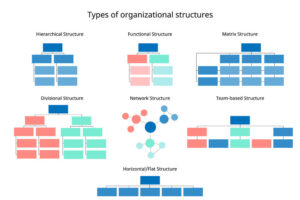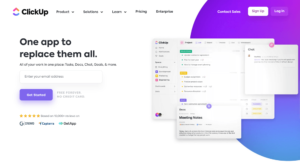Key Takeaways: Project HR Management
- Project human resource management covers everything from hiring, training, performance monitoring and team-building exercises.
- Effective human resource control can lead to increases in employee happiness and productivity.
- Popular project management platforms like monday.com and ClickUp can be used to effectively manage employees and the projects they’re working on.
It should come as no surprise that most project teams — even those comprising seasoned employees — need guidance, support, encouragement and coaching to succeed. However, not all leaders understand the importance of project human resource management and how employee management can be the difference between project success and failure.
In this guide, we’ll explain why employee resource management is a vital part of project planning. You’ll learn about employee planning and hiring, mentoring, team building, and why you should track employee performance metrics. We’ll also share a couple of project management platforms that can help set project team members up for success.
What Is Project Human Resource Management?
Project human resource management is the process of managing company resources and individuals on a project team. Project human resource management covers everything from hiring to training and organization to maximizing potential and tracking staff metrics.
HR project management is a vital cog in a project’s machine, and without it, a project could be staffed with the wrong people, deadlines could be missed, and budgets could have scope creep problems.
Why Does Project Human Resource Management Matter?
As you can imagine, a project has many moving parts, and project managers or Scrum masters must be on top of everything. However, with so many project tasks and goals to track, budgets to manage and clients to appease, it can be easy to lose track of the human aspect of projects.
Without human resource management, a project’s success could be jeopardized. If staff members working on a project aren’t properly selected, given appropriate project roles, don’t understand their key responsibilities and are poorly managed, a project could be delayed, employee morale can drop, trust can fail, and client expectations might not be met.
Fortunately, many project management methodologies, especially Agile methodologies like Scrum, champion open communication and encourage project managers to communicate effectively. Scheduled events like daily stand-ups, Sprint reviews and retrospective meetings allow leaders to share project goals, optimize performance and build teams.
These meetings also allow managers to enhance an overall team environment, touch base with individuals and go over progress reports. They’re also ideal for discussing project or training concerns and holding team activities that can increase team-member interaction. Development programs that can strengthen professional relationships can also be rolled out.
So, as you can see, project HR management is more important than you might think. Without human resource planning, the most important part of any project, the team members, can be mismanaged and put into unfamiliar roles, underutilized, underappreciated or might not know where they stand regarding performance and expectations.
How to Develop a Human Resource Management Plan
All the potential benefits of managing your human resources sound great; after all, who wouldn’t want to enhance project performance, develop team members and oversee a project’s success? The big question, though, is how do you create a solid plan for human resources? Below, we’ll cover the four steps you’ll need to follow to get the most out of your project team.
1. Design A Human Resources Management Plan
Every project is different. The first step is to develop a staffing plan that fits the current project. Managers must define the team’s structure, project roles and the responsibilities of those roles. Human resource availability must be checked, and the right people with adequate skill sets for the defined roles should be identified from within or hired. Backup employee options should also be identified.
Next, the HR team and project managers should discuss what training might be needed to bring team members up to speed and how team member performance will be tracked. Regular meetings should be scheduled, and leadership activities and rewards that can be used to build the team throughout the project should also be discussed and planned.
By the end of this process, you should have a strong staffing management plan that identifies key project roles and responsibilities. You should also know who will occupy the positions to complete project activities, the project resources needed, team training and encouragement methods, and how individual job performance will be tracked and measured.
2. Build a Team and Assign Roles and Responsibilities
Now that you have identified the team members for your upcoming project, it’s time to start team assembly. If you need to hire new permanent team members or freelancers (check out our guide on how to become a freelance project manager), get the ball rolling as soon as possible so that you don’t miss out on your top picks.

who they should contact should problems arise.
With the team assembled, it is time to assign roles and responsibilities. The easiest way to do this is to use a RACI chart. RACI charts, which are also known as responsibility assignment matrix charts, show key roles and position responsibilities. The charts are easy to read and update and are supported by many of the best project management software platforms.

Once every team role has been filled, the project manager — or Scrum Master — will be presented with an updated project management plan, new resource calendars and updated organizational structures (see our guide on organizational structures) that show where each team member sits in the chain of command. These documents will help ensure the project gets off to a flying start.
3. Team Bonding and Development
Having a fully assembled project team is one thing, but it will be for naught if the group has communication or trust issues going into a project. It’s absolutely crucial that management does everything they can to encourage transparency and open communication before, during and after a project.
Whether you’re managing a team in person or remotely via tools like Slack (here’s our Slack review), team building must occur. Ideally, team meetings, like retrospectives, will be used to encourage communication, to make everyone feel comfortable and for team bonding and developing project management skills. When a team feels comfortable and valued, you’ll likely see enhanced productivity.
Using team-building meetings to recognize achievements (team and individual) and project wins is also essential, as this will build morale. Anything management can do to improve productivity and interpersonal skills should be done during these meetings. If you want project success, don’t underestimate the importance of team building and development meetings.
4. Team Management
The final step is team management. By this point, you’ll have identified your team, assigned individual roles and built a friendly atmosphere that champions teamwork and development. That was the easy part, though. Now, project managers must manage their team throughout the project to ensure that team members are hitting the goals set during the project planning phase.
During the project, the project management team should be tracking team member performance, team velocities and overall project performance. The leadership team should also provide consistent feedback, look for conflicts and potential roadblocks, and sniff out undesirable behaviors and anti-patterns that could make the project falter.
If a project manager is in tune with their team, they should be able to ward off most problems. However, there may be times when a manager needs to make changes to their team due to sickness, unrest or underperformance. If the human resource and project management teams planned well initially, there shouldn’t be any problems replacing team members during the project.
Overall, the idea during this stage of project employee management is to get the most out of your selected team and optimize project performance so that you can get the job across the finish line efficiently, on time and under budget and please project stakeholders and clients.
Best Tools for Project Human Resource Management
Managers and human resource teams have a lot to organize and track. Fortunately, powerful project management software can help them quickly sort through a sea of information. Below, we’ll share a couple of project management platforms that can help track candidates and their training, schedule team-building meetings, and turn out detailed employee performance reports.
1. monday.com

its easy-to-use employee management tools.
Pros:
- Shallow learning curve
- Powerful dashboards
- Robust kanban boards
- Gantt charts & calendars
Cons:
- Weak free plan
- Robust security and admin options only in higher tiers
monday.com regularly is a favorite of ours, thanks to its powerful tools that make planning, organizing and tracking tasks and project phases straightforward. However, monday.com also has features and tools that can help managers track employees from onboarding through training and show you how they’re performing during projects.
Easy-to-use templates can help track attendance, performance and training plans. You can monitor your resource calendar and various HR projects. Dashboards allow you to monitor employee metrics, and you can use automations to remind your employees about performance reviews.
You can learn more about the software in our monday.com review and pricing in our monday.com pricing guide. You can also try monday.com’s free plan to get a taste of the program.
- Maximum users: 2, Kanban Board, & list
- Minimum users: 3, Price per user, Basic features
- Minimum users: 3, Price per user, Expanded features
2. ClickUp

that can track project tasks and employees.
Pros:
- Excellent free plan
- Management & HR tools
- Collaboration features
Cons:
- Clunky interface
- Weak mobile applications
ClickUp is another project management platform that can help you track recruitment, training and development, and also help you get through the multiple stages of employee onboarding processes. ClickUp’s detailed reports allow managers to track employee performance, and the instant chat tools make it easy to communicate with individuals and entire teams.
Additionally, ClickUp’s real-time collaboration tools can simplify employee processes and remote meetings, and templates for performance reviews and employee requests can help save time. These features are on top of the robust task management tools you’d expect to find.
You can learn about ClickUp in our ClickUp review. You can also learn about ClickUp’s strong free and paid plans in our ClickUp pricing guide. Finally, ClickUp’s free plan is excellent and a good way to get a feel for its features.
- Basic functionality with some limitations
- All prices per user
- All prices per user
Final Thoughts
It should come as no surprise that successful project teams have human resource specialists and project managers who hand-pick teams, provide training, monitor employee performance, offer feedback and hold regular team meetings. With effective human resource management, project managers will have no problems building a successful project team.
If you want to learn more about managing human resources, check out our guide to the best project management certifications. You’ll find courses like the Project Management Professional (PMP) offered by the Project Management Institute and the BVOP Certified Project Manager program. Both can help you become an effective coach and project manager.
What methods have you used to help successfully build a project team? Are there any other steps that you use to help train and coach teams? Do you feel more confident about project human resource management after reading this guide? Let us know in the comment section, and as always, thanks for reading.
FAQ: Project Human Resource Management
-
The main aim is to provide project teams with guidance, resources and tools that can help groups create efficient workflows and meet and exceed project goals.
-
Employee performance reviews are an example of a human resource project. Other projects include developing training plans, collecting employee feedback and holding recruitment events.
-
The three major processes are developing human resource plans and project teams and managing project teams.
The post Beginner’s Guide to Project Human Resource Management in 2023: How to Manage a Project Team appeared first on Cloudwards.

